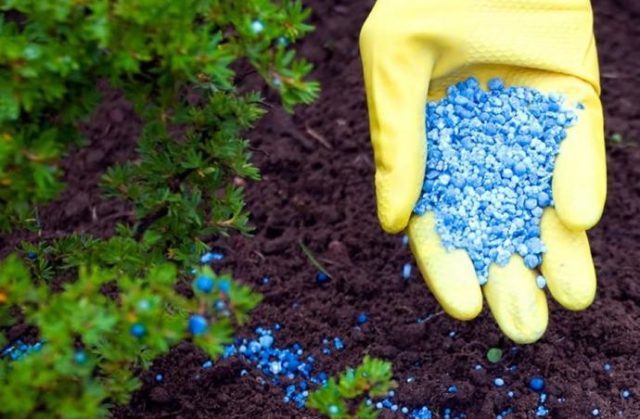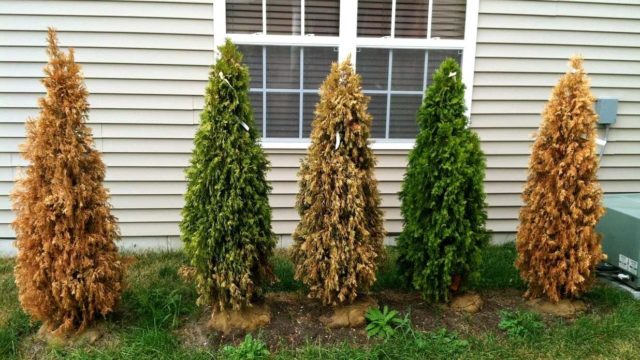Content
- 1 Why do you need to feed thuja
- 2 What dressings are suitable for thuja
- 3 Method of application
- 4 How to feed thuja for growth after planting
- 5 How to fertilize thuja in spring
- 6 Features of summer feeding of thuja
- 7 How to feed thuja in the fall in preparation for winter
- 8 How to fertilize correctly
- 9 Conclusion
Evergreen conifers, including thuja, are widely used in landscape design. During a long winter, they acquire a sloppy appearance, partially losing their decorative effect. Therefore, it is very important to feed the thuja in the spring, this will provide the trees with adequate nutrition for the entire season, as well as quickly recuperate after the cold season.
Why do you need to feed thuja
Thuja prefers loose fertile soils, but not all summer cottages can boast of it. Over time, the composition and structure of the soil near the trunk zone of the tree changes quite a lot, some of the nutrients are absorbed by the plant, while undigested minerals, on the contrary, accumulate. Negatively affects soil fertility and spring melting of snow. At this time, a significant part of nutrients and minerals is simply washed out by water into the lower horizons.
It is possible to restore the balance of trace elements and enrich the composition of the soil with the help of root and foliar dressings, which are an important part of the care of thuja in spring.
What dressings are suitable for thuja
For feeding thuja, you can use both organic matter and mineral fertilizers. Some gardeners use special complex fertilizers produced specifically for feeding conifers. Their price, as a rule, differs upwards from conventional fertilizers, but the effect of their application is much higher.
Mineral
The basis of mineral fertilizers for thuja in the spring are preparations containing potassium, magnesium and phosphorus. This is the main difference between feeding coniferous trees and deciduous trees, the main element of which in spring is nitrogen. Nitrogen stimulates the growth of shoots, a quick set of green mass. In early spring, this is very important for the growth of young leaves, but the presence of nitrogen does not have any significant effect on needles. Moreover, conifers perfectly assimilate this element from the air.
Nevertheless, it is still possible to feed the thuja in the spring for growth with nitrogen-containing fertilizers. However, this must be done very carefully. Most often, urea, ammonium nitrate, nitroammofosk are used as such fertilizers in early spring. They are introduced into the near-trunk circle, often in a dissolved form. Some gardeners embed the granules in the soil, combining feeding and loosening the trunks. Dry fertilizer dissolves and is absorbed much more slowly, therefore, repeated feeding is no longer performed.
From the beginning of summer, the introduction of all nitrogen-containing dressings should be stopped. Excessive shoot formation at this time of the year is no longer necessary and will only weaken the plant. Unlignified shoots will simply freeze out in winter.
Organic
Organic fertilizers are best used for feeding thuja in dry form in spring. In this capacity, you can use humus, compost, old rotted manure. All these fertilizers are simply embedded in the soil at a shallow depth in the root zone of trees.
Complex
You can fertilize thuja in the spring for growth with complex fertilizers. Such formulations are sold in concentrated form in gardening stores. These fertilizers include the following:
- Khvoinka.
- Green needle.
- Aquarin.
- Fertika-Lux.
- Health for conifers.
Complex dressings contain a large number of necessary thuja elements. The concentration of such fertilizers allows them to be used once every 3-5 years.
Method of application
Most gardeners apply groundbait by root, embedding granules or sprinkling liquid fertilizer on the trunk circle. However, this is not the only way to feed the thuja. The foliar method, which consists in spraying the crown with special compositions, has also proven itself well. The needles assimilate nutrients much faster and fuller than the roots, therefore, with this method, the decorative appearance of the thuja is restored much faster. It is estimated that foliar fertilization is 80% assimilated, while the effectiveness of root fertilization does not exceed 20%.
There are quite a lot of foliar dressings for thuja. Most actively used for this purpose are chelates - complex compounds that include metals in ionic form. Some of the drugs are:
- Quantum.
- Aminomax-N.
- Kafom Mg.
- Brexil Combi.
Chelates are used for foliar dressing of thuja in spring and summer at a frequency of about 1 time per 2 weeks. It is better to start spraying in early May and finish at the end of August.
How to feed thuja for growth after planting
For several years after planting, there is no need to feed the thuja, since the nutrient soil with which the planting pit is filled contains all the necessary nutrients. However, after 2-3 years, a significant part of them is either washed out of the soil or absorbed by the plant. You can quickly restore the nutrient content of the soil with the help of humus, which must be embedded in the soil of the trunk circle. This is very easy to do. 1-2 buckets of old humus must be scattered in an even layer around the trunk of the thuja, and then carefully dig up the near-trunk circle to a depth of 5-10 cm.
How to fertilize thuja in spring
Spring is the main time of the season, during which most of the thuja fertilizing and other care activities are carried out. At this time, you can use any top dressing with any method of application, however, you should strictly adhere to the recommendations of the fertilizer manufacturer in everything related to the order of application and the recommended dosage.
How to feed thuja after winter
Winter is a rather difficult time for conifers and for thuja in particular. All processes at this time are greatly slowed down, although they do not stop at all. In most regions, thujas winter under cover, and after removing it, the appearance of the tree often leaves much to be desired. Decorativeness can be quickly restored with the help of special multicomponent preparations, for example, Pro Bio Tech Reanimator. This drug can be used not only in the spring to speed up the restoration of appearance, but also for the rehabilitation of thuja after an illness or transplant.
In the first year after planting, there may be problems with the rooting of thuja seedlings. If there are violations, the root system of the young tree may be damaged and unable to fully support normal growth. After winter, this will be clearly visible in the color and condition of the crown. To help the root system, root stimulants such as Agrecol or Kornevin can be used in the spring.
How to feed thuja in spring for rapid growth
Nitrogen is a stimulant of rapid growth. Therefore, the use of nitrogen-containing fertilizers in the spring is quite justified, but only in small doses. An excessive amount of nitrogen will lead to a loss of decorativeness of the thuja, the crown will be looser. Thuja can be fed in spring for active growth with the help of multicomponent preparations, such as, for example, Megafol.
Features of summer feeding of thuja
Most gardeners do not feed the thuja in the summer, limiting themselves only to fertilizing in the spring. If the work was not carried out in the spring, in the summer it is necessary to limit ourselves to foliar dressing that does not contain nitrogen. Spraying the crown should be done on a cloudy but not rainy day, early in the morning or late in the evening. This is due to the fact that sunlight can be focused by water droplets, which will lead to crown burns.
How to feed thuja in the fall in preparation for winter
In autumn, thuja can be fed only in the southern regions. In September, you can add a little superphosphate by the root method or treat the crown with preparations from the Fitosporin series.
The subtleties and nuances of fertilizing thuja and other conifers - in the video:
How to fertilize correctly
All root dressings are applied directly to the thuja tree trunk circle. If the fertilizer is granular, then it is evenly scattered over the soil surface, and then the soil is gently turned up with a small hoe or rake. So the granules are embedded in the soil at a shallow depth. It is not recommended to use a shovel, since there is a high probability of damaging the thuja roots located close to the surface. In the same way, organic matter is embedded in the soil: humus, compost. If the fertilizer is applied in dissolved form, then it is dissolved in water to the desired concentration, and then evenly irrigate the root zone with the composition. In this case, you need to try so that the mixture does not get on the needles.
After applying the dissolved fertilizers, it is advisable to mulch the trunks. Peat, dry needles or bark, colored sawdust can be used as mulch. Mulching prevents rapid evaporation of moisture from the soil, helps to maintain the air permeability of the top layer of the soil, and also serves as a protective barrier against weeds.
Foliar dressing is done by irrigating the crown. To do this, you can use a spray bottle or spray. The required amount of the drug is dissolved in water to the desired concentration, and then the crown is evenly irrigated with the resulting composition from all sides.
Some gardeners believe that it is not necessary to feed the thuja. Indeed, fertilization is not always necessary. If thuja grows well and does not lose its decorative effect from year to year, then there is no point in further stimulating its growth. However, if there are negative changes, such as violations of the color of the needles, shedding it, weak annual growth, diseases, then in this case, feeding is necessary, since they can have a significant impact on the quality of the recovery process.
Conclusion
In most cases, if you feed the thuja in the spring, then you can refuse any feeding at other times of the year. Especially if you use for this purpose modern complex preparations specially designed to stimulate conifers. Their use in most cases is justified, since such compositions allow you to quickly restore the decorative effect of thuja, give it a healthy appearance, and strengthen the immunity of the tree.













